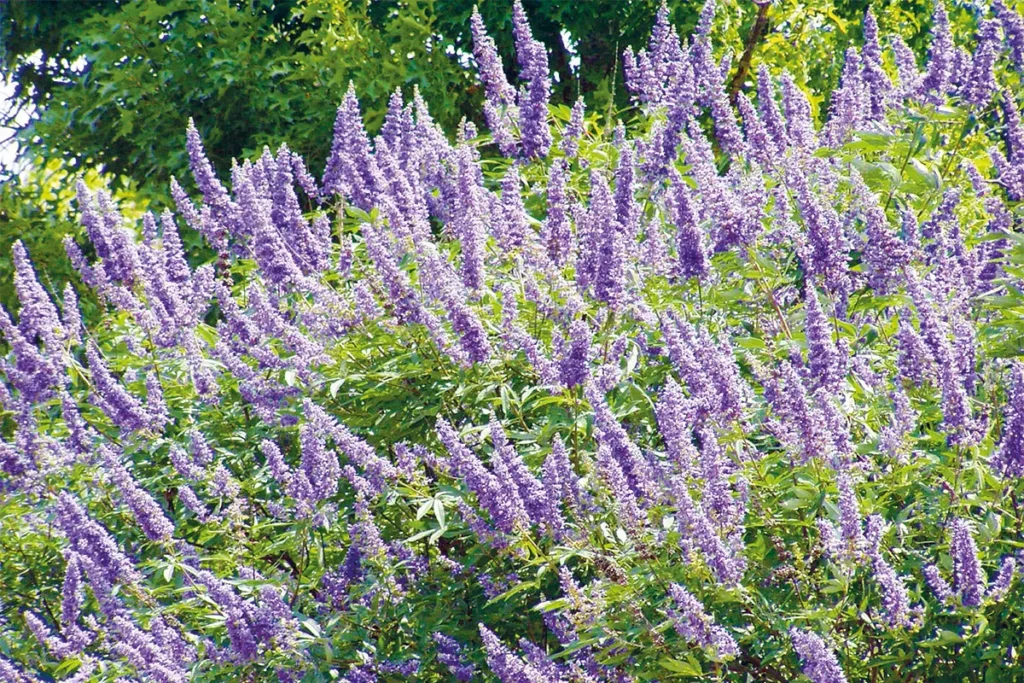


Nome Italiano: Agnocasto
Nome scientifico: Vitex agnus castus L.
Nome Gallurese: /
Descrizione:
L’Agnocasto è un piccolo albero o arbusto, alto fino a 5-6 metri. Ha foglie palmato-composte, aromatiche, di color verde scuro e bianco, tomentose nella parte inferiore; i fiori sono violetti, tubulari, riuniti in spighe lunghe e sottili, sbocciano tra giugno e settembre. Comunemente i fiori sono viola-lilla, talvolta bianchi. Il clima ideale è temperato e predilige i terreni freschi; comunque si adatta a qualunque tipo di suolo purché non secco. Cresce bene sia in pieno sole che in penombra. È una pianta spontanea e da giardino e cresce sugli argini dei fiumi e in luoghi umidi. I frutti (piccole bacche nere come grani di pepe) estremamente duri, odore aromatico, sapore amaro, leggermente pungente.
Proprietà e usi:
L’agnocasto è una pianta appartenente alla famiglia delle Verbenaceae ed è nota come falso pepe o anche pepe dei monaci. I frutti e i semi sono utilizzati per ottenere prodotti a uso medicinale. All’agnocasto viene attribuita la capacità di influenzare i livelli di diversi ormoni che controllano il ciclo riproduttivo femminile. Per questo si ritiene possa essere utile in caso di sintomi della menopausa, cisti al seno, infertilità femminile e prevenzione dell’aborto in caso di bassi livelli di progesterone.
Curiosità e miti:
I semi di questo arbusto, (o anche albero della castità), venivano somministrati come ipotetico anafrodisiaco per far fede al voto di astinenza dei monaci. Anticamente in alcune regioni del Mediterraneo si racconta di un uso “per raffreddare i bollenti spirti”, quando le donne lasciavano i mariti per rimanere caste durante le feste rituali.

Italian name: Agnocasto
Scientific name: Vitex agnus castus L.
Gallurese name: /
Description:
The chasteberry is a small tree or shrub, up to 5-6 metres high. It has palmate-compound, aromatic, dark green and white leaves, tomentose on the underside; the flowers are violet, tubular, arranged in long, slender spikes and bloom between June and September. Commonly the flowers are purple-lilac, sometimes white. The ideal climate is temperate and it prefers cool soil; however, it adapts to any type of soil as long as it is not dry. It grows well in both full sun and semi-shade. It is a wild and garden plant and grows on river banks and in damp locations. The fruits (small black berries like peppercorns) are extremely hard, have an aromatic smell and a bitter, slightly pungent taste.
Properties and uses:
The chasteberry is a plant belonging to the Verbenaceae family and is known as false pepper or also monks’ pepper. The fruits and seeds are used to make products for medicinal use. Chasteberry is attributed with the ability to influence the levels of several hormones that control the female reproductive cycle. This is why it is believed to be useful in cases of menopausal symptoms, breast cysts, female infertility and prevention of abortion in the case of low progesterone levels.
Curiosities and myths:
The seeds of this shrub, (also known as the chastity tree), were administered as a hypothetical anaphrodisiac to keep the monks’ vow of abstinence. In ancient times in some regions of the Mediterranean, it is said to have been used ‘to cool the boiling spirits’ when women left their husbands to remain chaste during ritual festivals.
